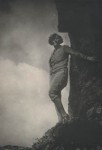
Anne W. Brigman
American, 1869-1950
The Bubble, 1910
toned gelatin silver print
2 3/8 x 4 in.
SBMA, Museum purchase with funds provided by Michael G. Wilson
1997.63

Anne Brigman Self Portrait n.d. Anne Brigman Papers
POSTSCRIPT
In "The Glory of the Open" and essay in the April 1926 issue of Camera Craft Brigman mentions two of her cameras:
"I looked at my 4x5 Korona View camera and the beloved Smith lens-NO! I was tired. I wanted to go and be free. I wanted the rough granite flanks of the mountains and the sweet earth. I wanted the stacatto song of wing around rocks and juniper branches. The little No. lA Ansco, with its 2 l/2 x 4 1/4 film, would do."[1]“Columbus made an egg stand on end by tapping it on the table. I make my negatives do things; but there is no black art, no combined negatives, no “stage claptrap,” as another New York newspaper art critic accuses them of having in their backgrounds. They are honest little negatives in their creation—the settings, backgrounds, lightings, all found in the wonderful wilds of the high Sierras, all planned for, and the psychological moment waited for, sometimes for days or weeks.
The etching tool is one of my closest allies. With it, all that is useless is etched away. Even the effect of mystery steals thorugh its keen edge, revealing itself in the finished print. So line of harmony is rendered more perfect and themotive, or underlying thought, enabled to appeal more clearly to the observer who undersands and responds according to his ability.
I believe it is Elbert Hubbard who says that reading is a collaboration between author and reader.
To refer again to the clipping: “curious things happen to plates, by accident or design, and prints from these plates may be used to represent almost anything.” In a way, he is right; for, though I use Sierra trees and crags and thunderstorms, they, the negatives, are not records of the topography of that country; they might be anywhere in the wide world. They hold, in pictorial form stories of the deep emotions and struggles or joys of the human soul in the form of allegory.
I realize that these “picture children” of mine are not understood because there has been no word of explanation sent with them into the mostly kind world. This little “Brook” of mine, for instance. A brook, a real brook, symbolizes joy, purity, glorious poise and strength, with the eternal reserve of the snow-clad peaks above it for its continued life. Lift this thought to the softly glowing figure in “The Brook.”
This, then, is my defense for daring to leave the beaten path, of using the camera as a partial means of expression of using its unswerving ability for fact and glorifying it with fancy and making the blessed little black box by faithful slave.
The negative of “The Thaw” was made in glowing midsummer, and there was not more than a million acres of snow in sight! A.B[2]
↑ Brigman, Annie W. "The Glory of the Open," Camera Craft 33, no. 4 (April 1926), pp. 155-163.
↑ Brigman, Annie W. "Just A Word," Camera Craft 15, no. 3 (March 1908), pp. 87-88.
COMMENTS
A ship captain’s wife who had trained as a painter, Anne Brigman turned to photography in 1902 and promptly joined Alfred Stiegltiz’s Photo-Secession. Most of her photographs depicted feminine nudes within natural Californian environments. Inspired by symbolist and romantic painting, the American photographer also drew on pagan mythology and her childhood Hawaiian beliefs, thus turning her sitters into poetic evocations of some sort of organic divinities. Not only did Anne Brigman highlight feminist ideals through her independent and active professional practice but also did she deliver a liberated portrayal of womanhood.
Brigman sought to achieve art with her camera at a time when the relatively new medium of photography was viewed as a largely documentary form. She manipulated negatives with paint and etching tools to get the effects she wanted, going so far as to add or remove features of the landscape—including trees and the moon. The inspiration for much of her work came from the California landscape, where she took photographs on extended camping trips in the mountains. As one of the first photographers to take the female nude in the natural landscape as a subject, Brigman’s work ties the female body to the natural world in a way that anticipates late twentieth-century ecofeminism and the societal and cultural connections it draws between women and the environment.
SBMA CURATORIAL LABELS
In 1994, with the support of the Santa Barbara Museum of Art Women’s Board, Karen Sinsheimer co-organized the exhibition A Poetic Vision: The Photographs of Anne Brigman. The installation was a testament to the Brigman’s contributions to the early 20th-century pictorialist movement and her distinctive and mystical scenes of California’s natural world. In the 1990s Sinsheimer acquired ten of Brigman’s photographs. This particular work, The Bubble, featured on the cover of the exhibition catalogue, joined the permanent collection through the generosity of Michael Wilson, a former SBMA trustee who befriended and supported Sinsheimer and the Museum’s photography department. In the introduction to the exhibition catalogue, Sinsheimer wrote: “Anne Brigman, put simply, had the soul of an artist.”
-Ridley-Tree Gallery 2016
